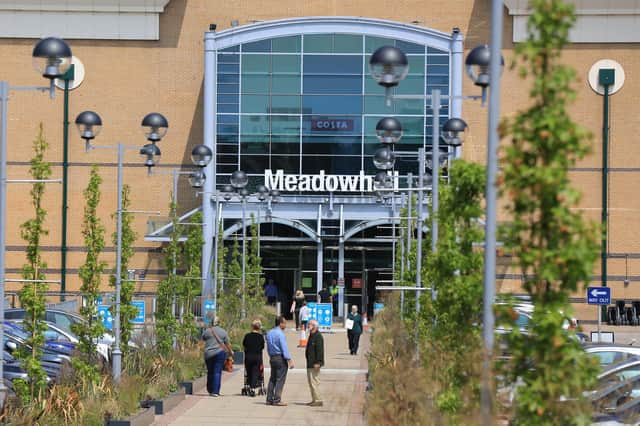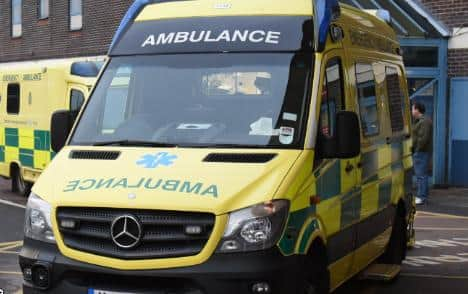Tragedy as man, 38, died in front of parents after collapsing at Sheffield's Meadowhall shopping centre
and live on Freeview channel 276
Mark Bennett collapsed in Boots, inside Meadowhall shopping centre, in April last year after suffering a pulmonary embolism as a result of reduced mobility caused by an ankle sprain 10 days prior.
His parents, Steven and Elaine Bennett, had to wait more than 50 agonising minutes for paramedics to arrive after their son collapsed, the inquest into his death was told.
Advertisement
Hide AdAdvertisement
Hide AdDespite best efforts by members of the public and paramedics, Mark, 38, was pronounced dead.
Sheffield's Medico-Legal Centre heard on Tuesday, September 19 how IT worker Mark suffered deep vein thrombosis (DVT) just 10 days after he had “landed awkwardly” after slipping on some stairs at a London Underground station on the morning of April 4.
It was heard that Mark had attended Royal Free Hospital in London, and he had been fitted with a cast boot after his foot had showed signs of ligament damage. He was advised to exercise his leg, and to take paracetamol if required.


Giving evidence, Steven said his son was recovering at their home in Grimsby, Lincolnshire, but continued to complain of pain at the back of his right leg which “varied in intensity”, and his calf was “extensively” bruised.
Advertisement
Hide AdAdvertisement
Hide AdOn April 11, Mark visited A&E at Grimsby’s Diana Princess of Wales Hospital, where he was assessed by an orthopaedics doctor.
A spokesperson of the hospital, which is run by Northern Lincolnshire and Goole NHS Foundation Trust, said Mark had been diagnosed with a sprained ankle after an X-ray found “no obvious bone injury”. There was reported to be “minimal swelling” at the front of and outer ankle.
A letter sent to Mark’s GP found that his calf had been examined and was “soft and non tender”. The main features of DVT are swollen veins that are hard and painful to touch, as well as swelling of the affected leg.
Mark’s symptoms did not meet the criteria for DVT prophylaxis, which would have been blood thinning medication to prevent DVT. A further follow-up appointment was scheduled for three weeks later.
Advertisement
Hide AdAdvertisement
Hide AdIt was heard that DVT can develop over 24 to 48 hours and could have developed after his visit to the hospital.
Three days later, on April 14, Mark visited Meadowhall with his parents.
Steven was waiting outside Boots when Mark called him and whispered down the phone: “I feel funny. Come quick”.
When Steven walked inside the store, staff were already administering CPR to Mark who had collapsed in an aisle.
Advertisement
Hide AdAdvertisement
Hide AdSteven told the court how paramedics arrived over 50 minutes later, while he and his wife watched on as Boots staff battled to save their son’s life. He described it as a “traumatising experience”.
He said: “We watched paramedics arrive and they started to examine him. One turned to me and asked about Mark himself, and I said I believed he had DVT... I believe paramedics took it on board because he looked at me directly.
“The paramedics decided it was time to take him into the ambulance so they loaded him onto the trolley and discussed a way out.
“Minutes later we were told to go with members of staff and they were in tears, especially the women that were there at Mark’s side trying to help. I took that as something really serious.
Advertisement
Hide AdAdvertisement
Hide Ad“One paramedic said 'can I have a word'. They took us to one side and gave us the news that Mark had died. Then we were asked if we would like to see him and we were taken into the back of the ambulance.”
Steven said a paramedic told him: “Even if we could bring him back, he wouldn’t be the same person.”
Giving evidence, James Goulding, Yorkshire Ambulance Service’s clinical response and governance manager, said the service was “beyond struggling” with lack of resources and an influx in calls on the day of Mark’s death.
He reported that YAS first received a call at 2.10pm abut Mark, who was struggling to breathe. A buddy-up system previously used by ambulance trusts means that the call had been taken by South East Coast Ambulance Service on behalf of YAS, and it was coded as Category 2.


Advertisement
Hide AdAdvertisement
Hide AdAll Category 2 calls could become Category 1 if not seen in a “timely manner”.
National guidelines ask that all ambulance trusts respond to Category 2 calls in 18 minutes, and respond to 90 per cent of Category 2 calls in 40 minutes.
Category 1 calls must be responded to in seven minutes on average, and 15 minutes in 90 per cent of calls.
Another call was made to YAS at 2.47pm when Mark had stopped breathing, which would have seen this callout upgraded to Category 1, but it was heard in court that this call took nine minutes to be answered. At that same time, there was a missed opportunity to dispatch an ambulance to Mark.
Advertisement
Hide AdAdvertisement
Hide AdAssistant coroner Stephen Eccleston said these circumstances “lost Mark a number of minutes”.
An ambulance was later dispatched to the now Category 1 call at 2.58pm, and arrived at Meadowhall at 3.03pm. Paramedics were at Mark’s side at 3.09pm where he was in cardiac arrest, but sadly he was pronounced deceased at the scene at 3.30pm.
Mr Goulding said national guidance for paramedics on treating pulmonary embolisms is “a little vague”.
Concluding, Mr Eccleston accepted the pathologist’s medical cause of death as pulmonary embolism, DVT, and immobility related to a leg injury, and ruled Mark’s death as an accident.
Advertisement
Hide AdAdvertisement
Hide AdA 'prevention of further deaths' report, was issued to both Yorkshire Ambulance Service and the organisation related to ambulance trusts’ national guidance to establish the best practice for treating pulmonary embolisms.
Comment Guidelines
National World encourages reader discussion on our stories. User feedback, insights and back-and-forth exchanges add a rich layer of context to reporting. Please review our Community Guidelines before commenting.
